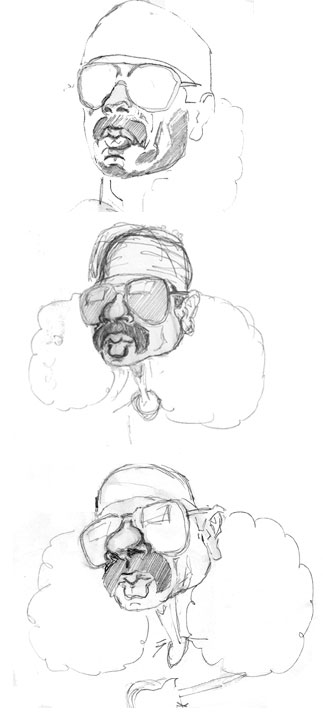| Good day everybody! I did something a little different today. A member recently requested another "progression series" of a caricature - he didn't want to wait for the next case study. I thought "why not?" I'm tight on time today, I'm out of fresh fine point pens, and I have the "progressions" already drawn. It'd just be a matter of taking a couple and collaging them in Photoshop. Progressive exaggeration What's a "progression series"? You've probably already figured it out, but it's just a simple series of pictures that show progressive exaggeration. I started this week with a picture of Carlos Santana. (See attached.) The picture on top is a fairly realistic - in fact a traced - version. (I got the picture off the Internet. Rolling Stone's March 16th 2000 features Carlos - this year's Grammy sweeper.) None of the three pictures get too wild but look for this: pick each element and follow it in each picture. For example, start with the head. Watch how it changes in the three pictures. Look at the glasses - how do they compare in size with the nose as you move down the series? What happens to the nose from picture to picture? What happens to the nostrils and lips? Same with the distance between the bottom of the lip and the bottom of the chin. The jaw line? the hair? Go through your list of "Mr. Average" landmarks. Look for the same old landmarks Apply what you know about the main landmark lines of the face: the "middle of the eye line", "the bottom of the nose line", and the "lip line". Ask yourself and observe how these change (or don't change) through the three pictures. Finally, do the three still bear a resemblance to Mr. Santana? Tracing I used 14" x 17" Strathmore Tracing paper, (41 g/square meter) and if you feel tracing is "cheating", I'm not the only one using it. I learned a gang this past Tuesday at the National Caricaturist Network Annual Convention in San Diego. In fact I saw one of our national elite caricaturists Mr. John Katsch, use tracing paper extensively to take the best from one of his many sketches and "import" it to another picture through the tracing paper. It's really only smart if you think about it! Not something you can really do at a gig, but beginners and experts alike can multiply their efforts with wasting just a minimum of time. (This is a great method when you have a picture you "just have to get perfect".) Another benefit of tracing is the ease with which you can identify shapes, Detail disappears and shadow shapes, highlight shapes, negative spaces, etc. all pop into view. And this fits nicely with the most recent "Light and Shadow" upload, (new upload on the way too). Assignment So my suggestion this week: trace a face and then retrace it 5 or 6 times adding calculated exaggerations with each take. Eventually you'll come up with your own very humorous, and/or very distorted picture. Give it a go and have fun with it! Until next time, keep on drawing. Warmly, Jeff Carlos Santana: Progression Series
|
